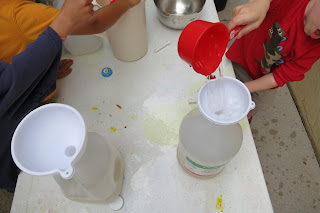Measuring liquids is wet, messy math!
Today's Topic: Measuring Liquids
Supplies:
Water
Funnels (optional, but very helpful!)
As many of the following as you can gather:
-measuring cups (both liquid and dry work well, plastic recommended)
-measuring spoons
-baby bottles with measurements on the side
-children's medicine syringes, spoons or the cups that come on top of a bottle of children's tylenol
-rain gauges
-mixing bowls with measurements
-gallon jugs
-plastic or cardboard pint or quart containers
-plastic cups in various sizes and shapes (to do a more simple "which one holds more?" test)
Book:
This is a great non-fiction book about the topic! All of the fiction titles I found were way too long for read-alouds. This one keeps it simple, includes a few experiments and has a hint of a storyline with high quality photographs of an African American family measuring liquids in several different settings (more vs. less, measuring medicine, etc.)
What Kids Do:
Okay, I have to be honest with you. I'm not sure how much actual measuring was accomplished in class, but everyone had a grand old time transferring water from one container to another using the various measuring tools we'd given them!
When his mom asked how much water this guy had, he said, "Five pounds!" Hey, that's measuring! :)
I also noticed a repeated skill from a past class when someone set up containers below the edge of the table to catch drips. Hooray once again for knowledge building on past lessons!
Adult Challenge of the week: Ask "I wonder" questions, like "I wonder which container holds more water?" or "I wonder how many teaspoons are in a half-cup?"
Hindsight Tip: If you REALLY want this to be a first lesson in measuring liquid, be sure to have plenty of plastic liquid measuring cups (we ended up with none!) and demonstrate the "get down to eye level and put the container on a flat, solid surface" concepts before letting the kids go nuts with the water. You might also want to incorporate a note-taking element to the lesson to drive the concept home a little stronger. That being said, the kids had a great time pretending to measure and they played way longer than I would have imagined they could with such simple tools. Water is always a big hit. But doing the class outside on the sidewalk on a lovely warm day was DEFINITELY a good idea.
Variations to try:
You could simplify this lesson further by just doing a "more or less" theme and not worrying about getting actual "accurate" measurements. More and Less are important early math themes, after all!










No comments:
Post a Comment